A pictorial history compiled by Geoff Goodall
TRANSCONTINENTAL AIR SERVICE PERTH-ADELAIDE - AND THE END OF THE AIRLINE
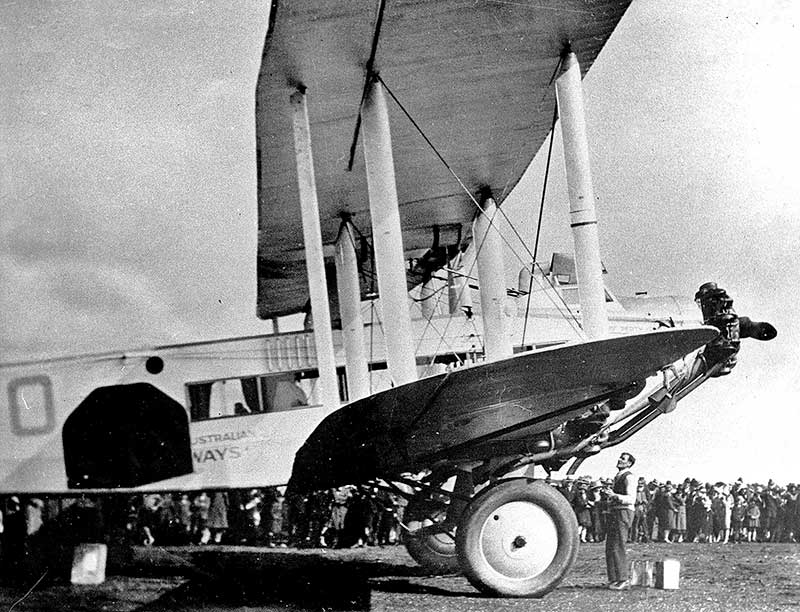
Here G-AUJO prepares to depart Parafield for the inaugural two-day service from Adelaide to Perth
WAA's submission for a Government air mail contract to make the Transcontinental route financially viable proposed four new
de Havilland DH.66 Hercules which Imperial Airways used on some international routes. A weekly two-day service in each direction would refuel at Kalgoorlie, Forrest and Ceduna, with a scheduled overnight stop at Forrest where passengers would be accommodated in a guest house on the airfield.
WAA was awarded the air mail subsidy ahead of 20 bids from other operators. A new share issue secured the £100,000 outlay required to purchase the DH.66s and cover the other costs associated with establishing Australia's first Transcontinental air route. The DH.66s had seating for only 7 passengers but freight holds for bulky mail sacks and general cargo. The four Hercules were shipped from England to Fremantle and assembled by WAA at Maylands Aerodrome. They entered service painted as G-AUJO to G-AUJR but within a year had changed to the new Australian regstration series as VH-UJO to VH-UJR.
| Registration |
c/n |
Reg |
Name |
Fate |
| VH-UJO |
344 |
28.5.29 |
City of Perth |
sold 4.36 to E.J.Stephens, New Guinea |
| VH-UJP |
345 |
27.5.29 |
City of Adelaide |
sold 4.36 to E.J.Stephens, New Guinea |
| VH-UJQ |
346 |
21.6.29 |
- |
sold 5.31 to Imperial Airways, to G-ABMT |
| VH-UJR |
347 |
18.9.29 |
- |
sold 6.30 to Imperial Airways, to G-ABCP |
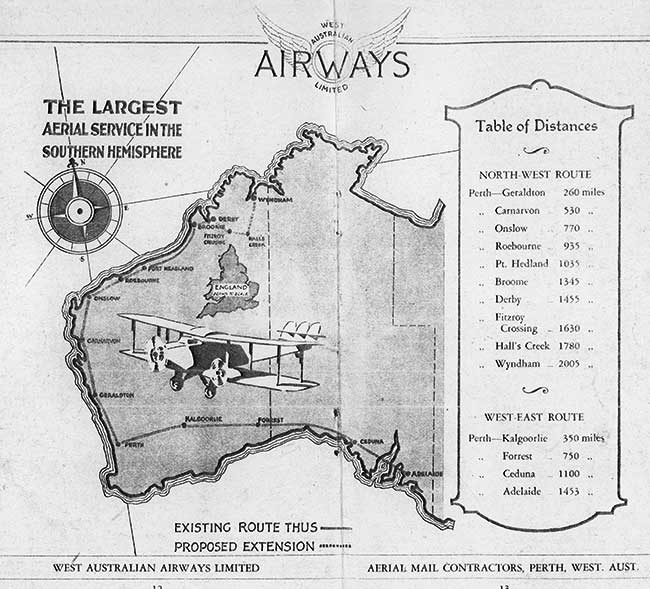
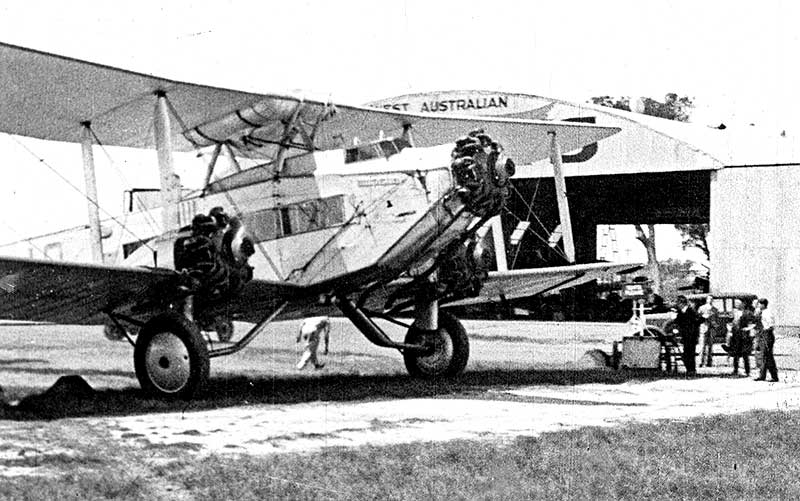
These large biplanes carried only 7 passengers in wicker chairs at a stately 100 miles per hour nil-wind ground speed
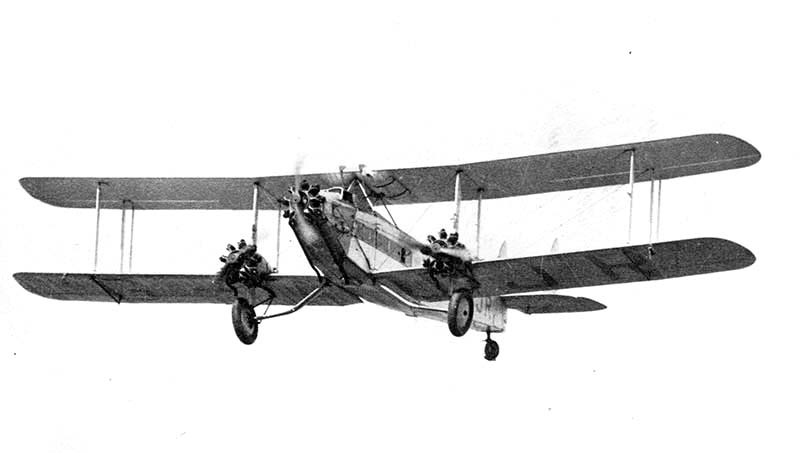
mainwheel brakes, rather than the simple tailskids of Imperial Airways DH.66s
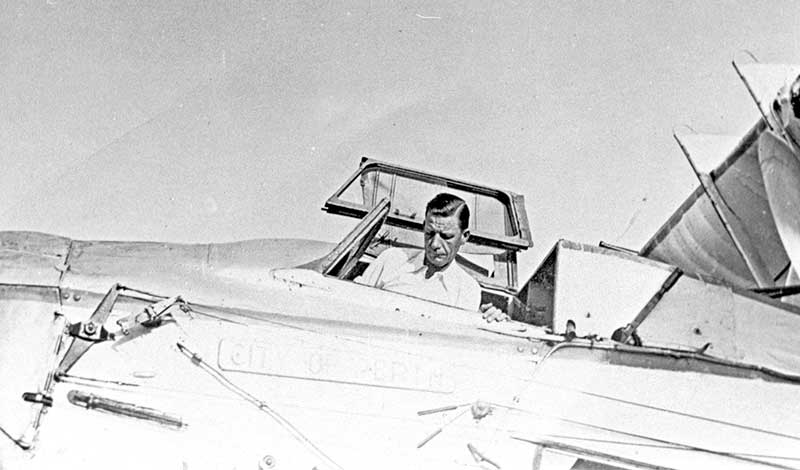
Other DH.66 modifications specified in the WAA order were an folding cockpit canopy to give the pilots some protection
and the metal cover immediately behind the cockpit which enclosed the petrol engine auxiliary power plant.
Both can be seen in this view of WAA pilot Stanley Brearley, Norman's brother
and the metal cover immediately behind the cockpit which enclosed the petrol engine auxiliary power plant.
Both can be seen in this view of WAA pilot Stanley Brearley, Norman's brother
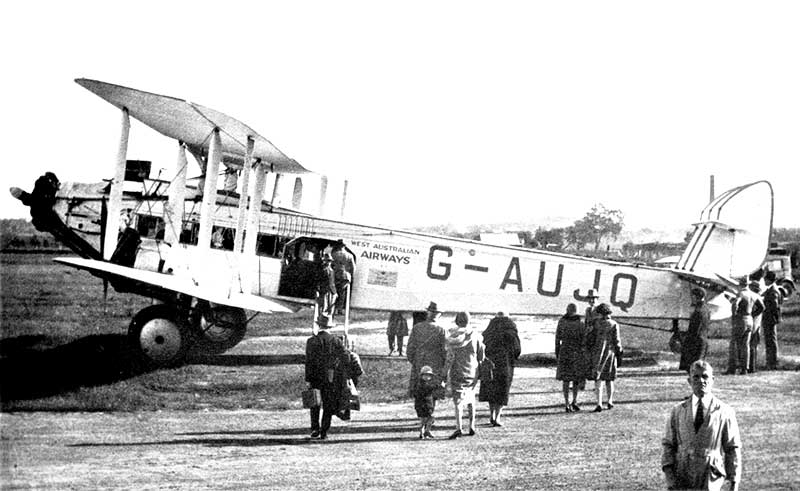
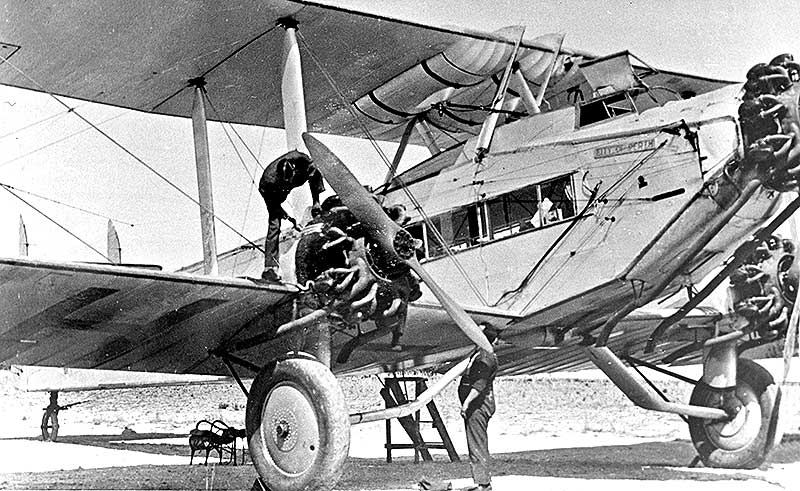
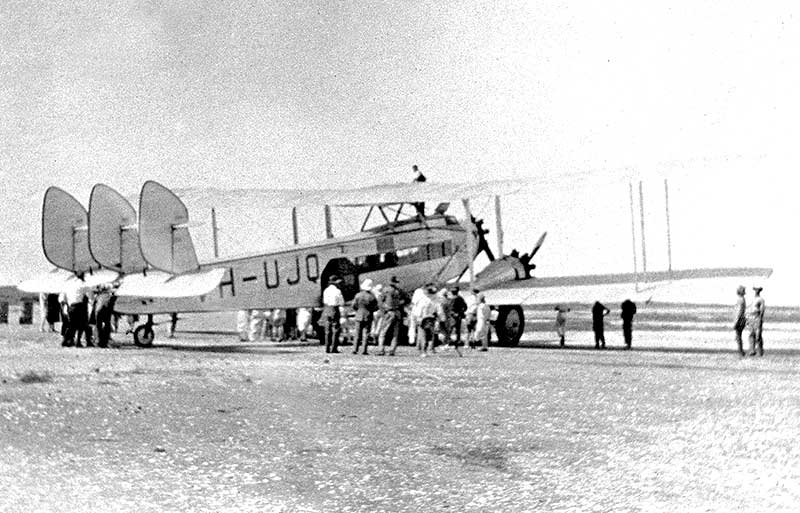
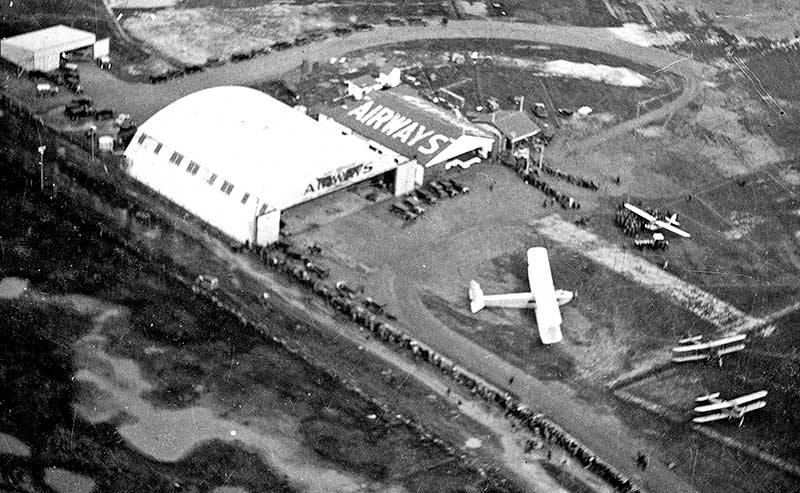
The crowds were waiting for a glimpse of Amy Johnson, who had just arrived in a DH.75 Hawk Moth on her Australian tour
following her solo DH.60 flight from England
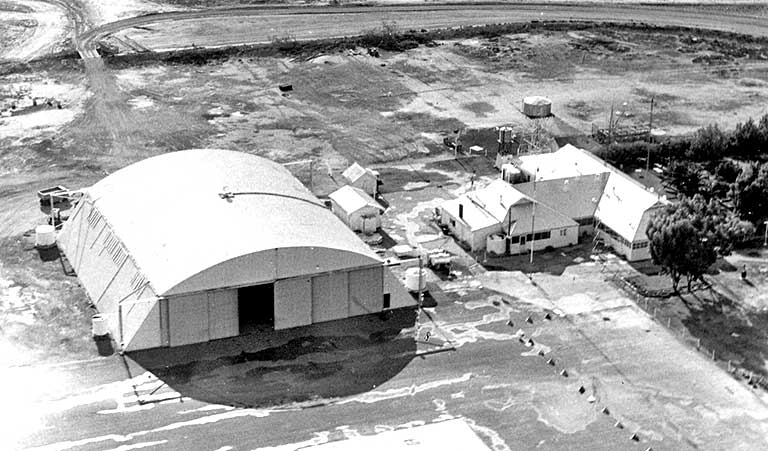
Forrest in 1972 showing the WAA hangar and passenger hostel built in 1929. The hostel had been extended over the years
to accommodate DCA Aeradio unit, radio navaid equipment, technicians room and a Met office. Photo by Geoff Goodall
to accommodate DCA Aeradio unit, radio navaid equipment, technicians room and a Met office. Photo by Geoff Goodall
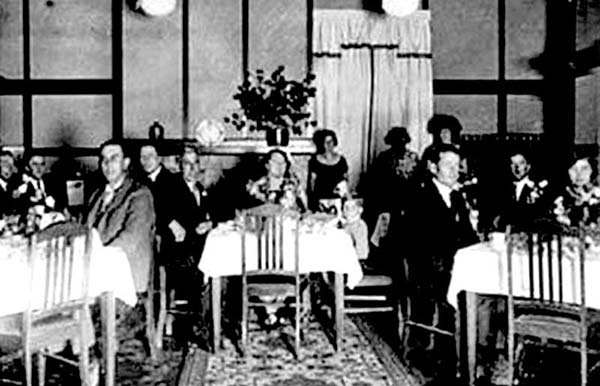
eastbound and westbound flights enjoyed fine dining during their overnight stay
Each eastbound service could not depart Perth until the Eastern States air mail had been transferred from the British mail ship at Fremantle and loaded on board the aircraft at Maylands. Shipping delays meant the WAA service often departed late in the day and flew into the night to reach Forrest. Brearley was anxious to have night flying facilities along the featureless route and waged a war with the Civil Aviation Branch: he personally cancelled the CAB order with General Electric for what Brearley believed to be an inadequate lighting system and instead ordered the manufacture of his own design. Senior CAB official Captain Edgar Johnson reinstated the original GE order, which on arrival in Australia was tested and proven ineffective. It was placed in storage and never used. Unfortunately this was one of many examples of Norman Brearley's high-handed tactics which antagonised the senior men of the CAB in Melbourne.
But in the meantime, Brearley had 18 Sperry rotating beacons installed on 50 feet tall towers along the route segment Perth to Cook SA where most of the night flying was occurring. He also arranged flood-lighting of the Forrest landing area, importing a huge beacon (designed for a shipping lighthouse) from England which was mounted on a car chasis with an electrical generator. It was driven to the required airfield location to give a 180 degree spread of lighting along the best landing area.
The DH.66s proved reliable and gave dependable, if slow, service mainly on the East-West route and also when required were utilised on WAA's North-West coastal service from Perth to Derby. The sliding cabin windows could be opened, giving passengers the convenience of throwing out used sick-bags in flight. Early in the service, when strong headwinds were encountered, the DH.66s lacked the range required over the long route sectors. On 29 October 1929 Eric Chater and Norman Brearley in G-AUJP were inbound to Forrest from Adelaide, pushing against 30 knot headwinds. It was after dark and the fuel tanks were indicating almost empty. Norman later wrote:
"We were about eight miles from Forrest when all three engines stopped. Chater landed close to the railway line with the aid of the plane's landing lights. In about an hour a small rail trolley came out from Forrest, bringing an engineer to investigate the trouble and also hot drinks for the passengers. Our hostel staff had learnt of the plane's progress from messages received from railway camps along our route and had estimated where we would have been. Then started a most unusual shuttle to and from Forrest as the little rail trolley was only able to carry
a few people each trip. Further trips were made with bags of mail and the passengers' luggage. The following morning the schedule was maintained using the spare Hercules stationed at Forrest, while Chater brought the stranded plane into Forrest after taking on sufficient petrol."
The range problem was quickly solved by the installation of an additional fuel tank, designed and built by WAA staff at Maylands.
The contract negotiated by Brearley before the prototype flew included a financial penalty against Vickers for every mph the aircraft cruised below their guaranteed speed. Vickers sought a bonus payment for every mph above that speed, to which he readily agreed. His experience with British aircraft manufacturers was vindicated when Vickers flight tests of the prototype revealed a cruising speed 15 mph below the predicted speed and the WAA sales price was reduced accordingly. It was one of the few "wins" WAA was to have with the Viastras.
| Registration |
c/n |
Reg date |
Fate |
| VH-UOO |
1 |
18.2.31 |
Retired Maylands .34, scrapped 6.39 |
| VH-UOM |
2 |
8.10.31 |
Forced landing Recliffe, Perth 11.10.33 |
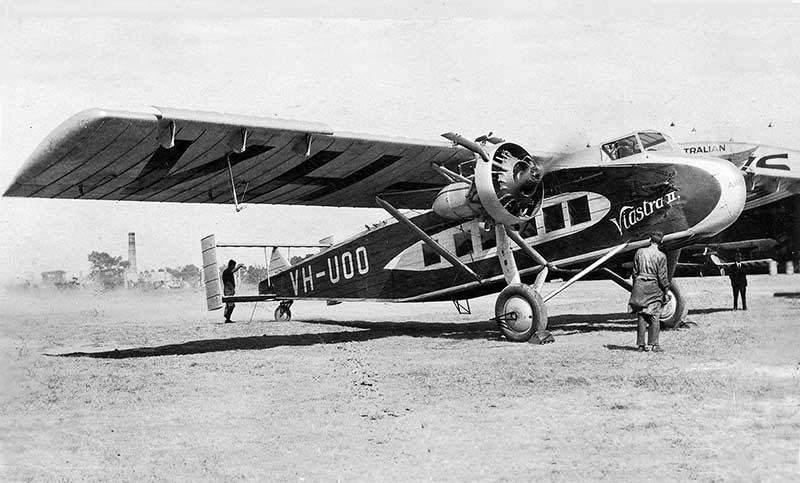
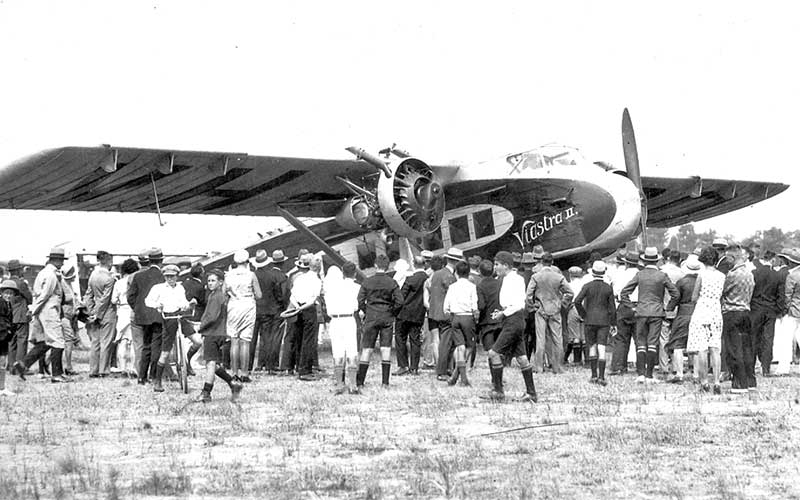
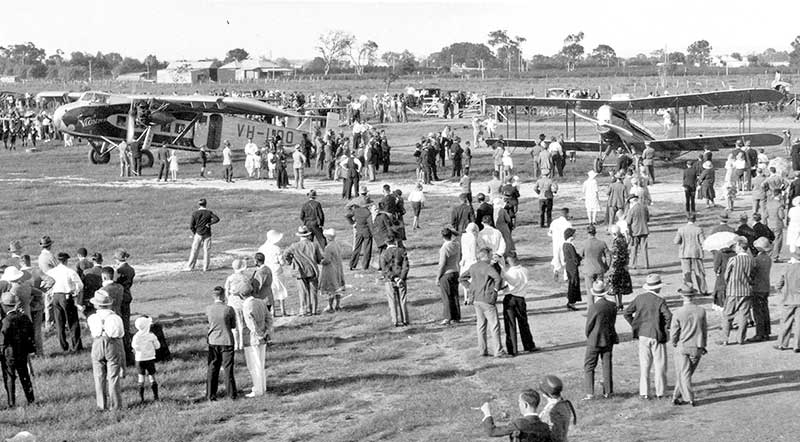
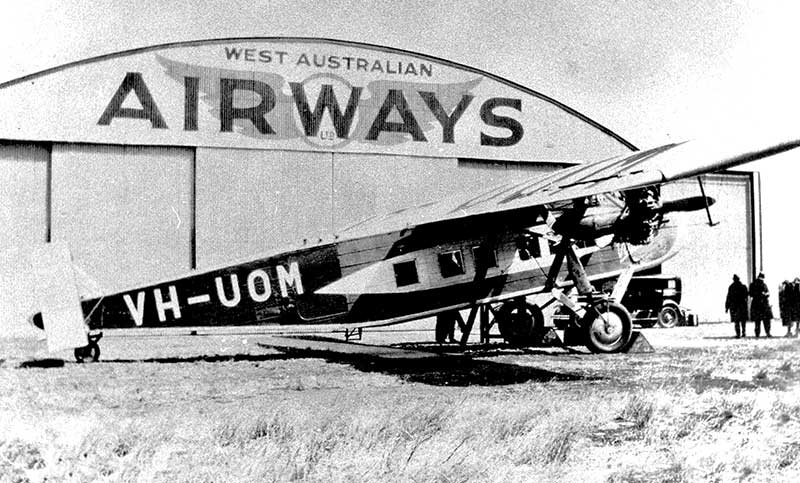
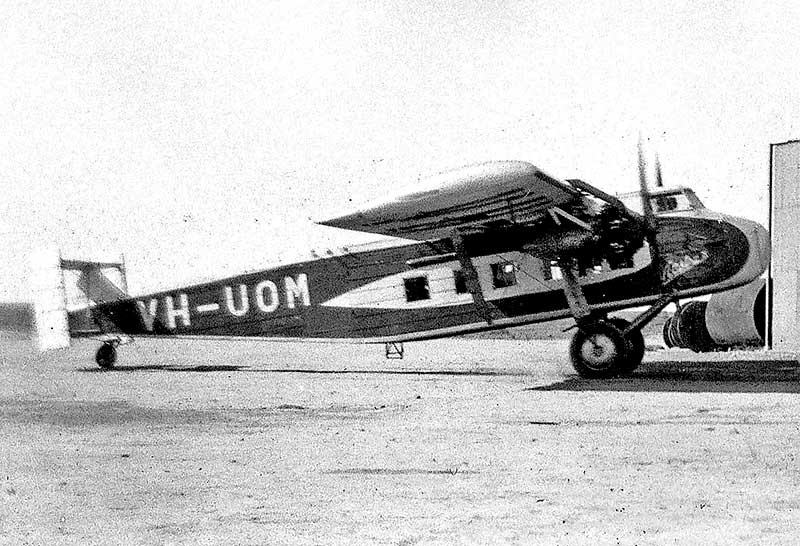
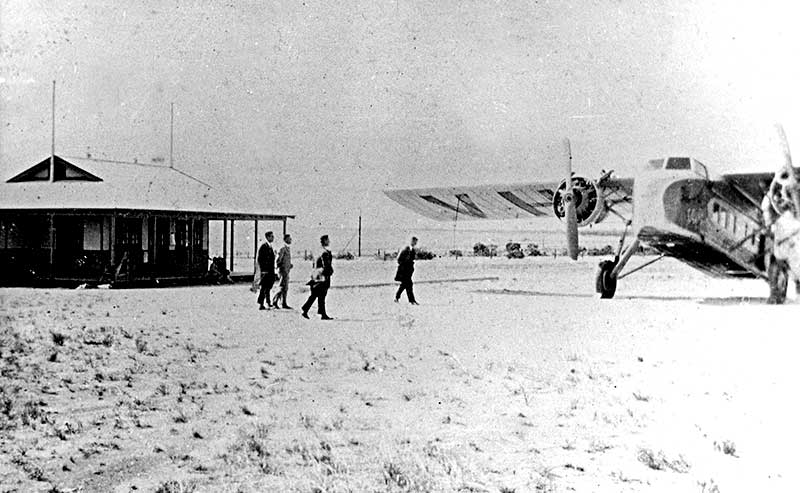
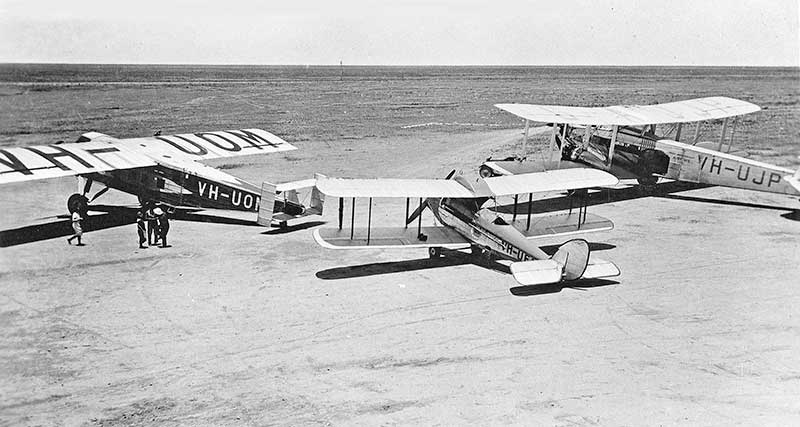
View from the WAA Forrest hangar roof in January 1933, showing Viastra, DH.50 VH-UEM and reserve DH.66
21.4.31 VH-UOO 20 miles west of Forrest, Captain James Woods
25.4.31 VH-UOO 60 miles west of Ceduna, failure starboard engine, Captain Stan Brearley
17.6.31 VH-UOO near Broom Tanks, Captain Stan Brearley
1.9.31 VH-UOO near Northam, due port engine. Captain Stan Brearley
29.9.31 VH-UOO returned to Maylands after departure due engine trouble, Captain James Woods
19.1.32 VH-UOO Burracoppin to repair oil pipe
24.1.32 VH-UOO Southern Cross, to repair broken oil pipe
30.1.32 VH-UOO Kyancutta
14.2.32 VH-UOM 28 miles west of Naretha, Cpt James Woods
26.4.32 VH-UOO Boorabbin, due port engine failure, Captain James Woods
10.5.32 VH-UOO 946 mile Camp, due port engine, Captain James Woods
14.8.32 VH-UOM Southern Cross, due engine failure, Captain James Woods
25.12.32 VH-UOM 744 mile peg, due seized engine, Captain Stan Brearley
21.1.33 VH-UOM Darkes Peak, Captain James Woods
28.3.33 VH-UOO Tammin, due port engine failure, Captain James Woods
11.10.33 VH-UOM Redcliffe, Perth, engine seized, prop burst. Wrecked. Captain Harry Baker
When the CAB Maylands inspector arrived at VH-UOM's crash site, blood and feathers were on the port engine. WAA staff claimed the pilot had told them them that the propeller hit a large bird at around 5,000 feet. The wary inspector took samples of the blood which he had analysed by the University of WA and determined to be from a domestic chicken. His investigation confirmed that the engine drive gear had seized, bursting the wooden propeller at its hub. The company's claim of a propeller bird strike was considered to be a deliberate subterfuge to divert attention from yet another seizure of the drive gear.
It was the final straw for the Civil Aviation Branch, following an acrimonious dispute running since April 1931 when Brearley had requested CAB approval to install two spare DH.66 ungeared Jupiter XIFs engines to VH-UOO. Before CAB Head Office had considered the effect of the reduced engine power, reports were received that Viastras were flying the East-West route with various combinations of geared and ungeared engines on the same aircraft, requiring the pilots to balance the different power setting on each side. A large four-bladed wooden prop from a RAAF Westland Wapiti had also been used. In June 1931 while being severely reprimanded by CAB, Brearley instructed that the Viastra leading edge wing slats, which he considered ineffective, be removed - again without prior CAB approval.
Officialdom was to settle the ledger in 1934 by taking the NorthWest route from West Australian Airways.
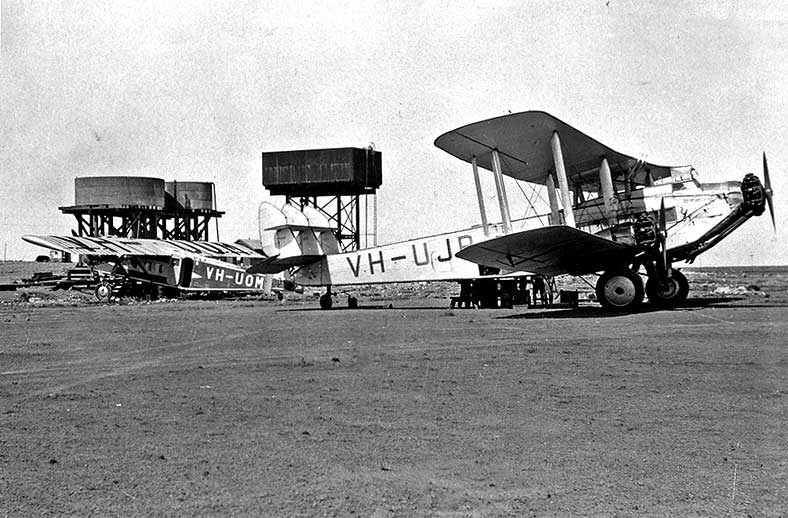
VH-UJP at Zanthus railway siding on the Nullabor Plain. The DH.66 had brought a replacement engine and propeller
for the u/s Viastra VH-UOM which made a forced landing here
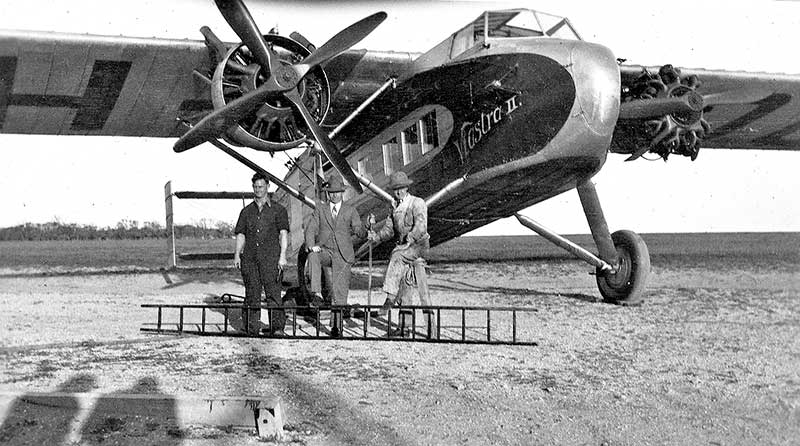
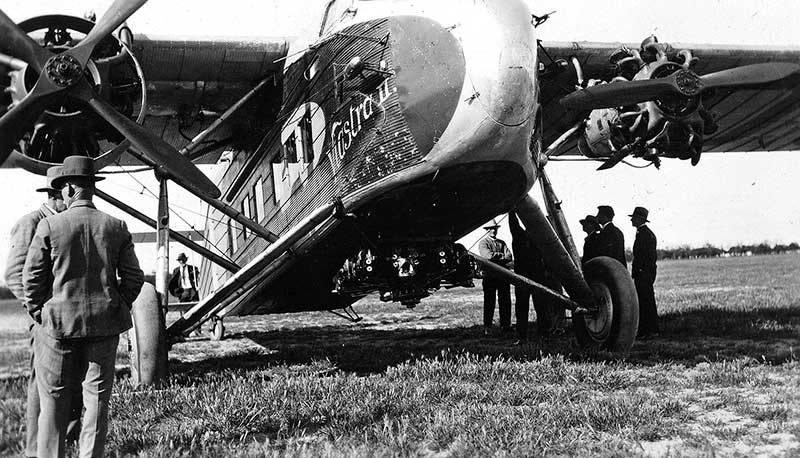
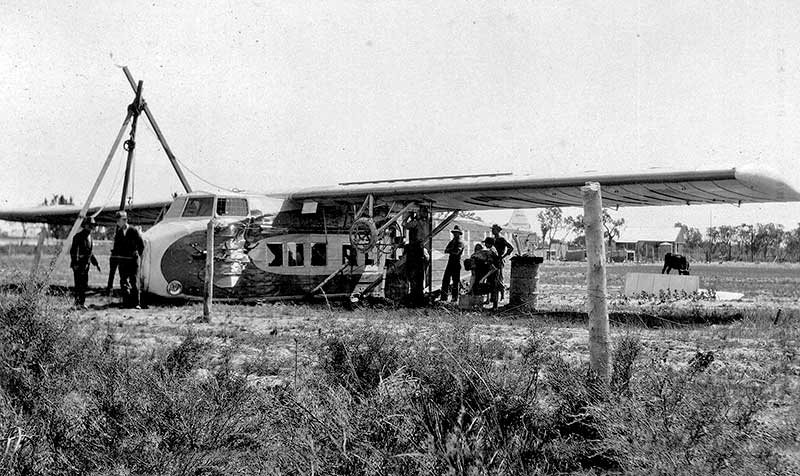
The seized port engine has been removed for Civil Aviation Branch investigation
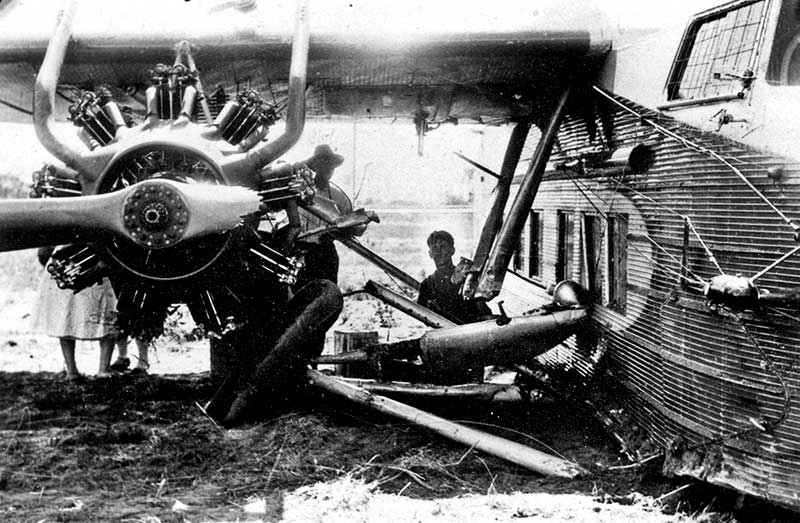
The wooden propeller blades of the starboard engine shattered when they struck the ground
The air mail subsidy was extended from Derby to Wyndham in July 1930. The worldwide Great Depression of the early 1930s caused a serious downturn in passenger and freight demand, but the airline maintained basic services. The mainstay DH.50s were supplemented by a pair of larger DH.61 Giant Moths fitted for 9 passengers. Just like the DH.50s the pilot sat in an open cockpit behind the cabin and conversed with his passengers through a viewing hole in the dashboard.
VH-UTL Old Gold was purchased in May 1931 from MacRobertson Miller Aviation Co in Adelaide and VH-UQJ was a second-hand British aircraft shipped out and assembled at Maylands in February 1932.
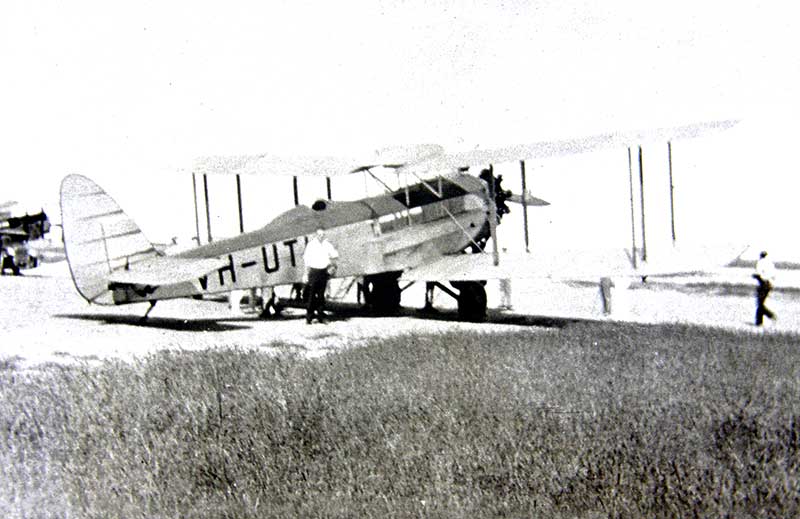
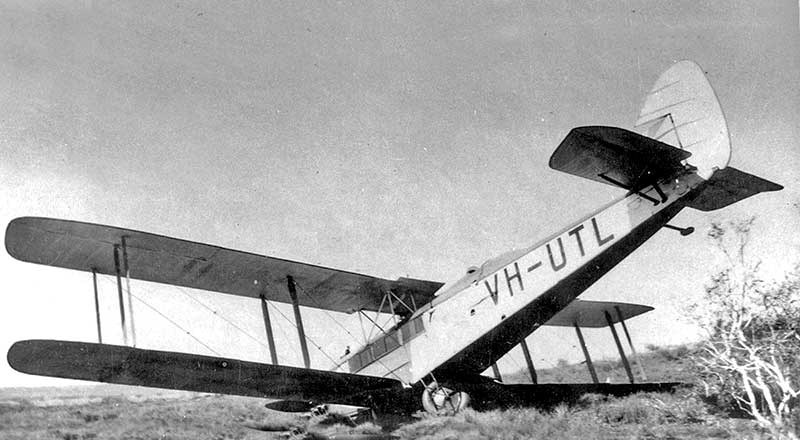
had a similar event at Broome airfield only two weeks later on 30 March 1934, when two passengers were hurt
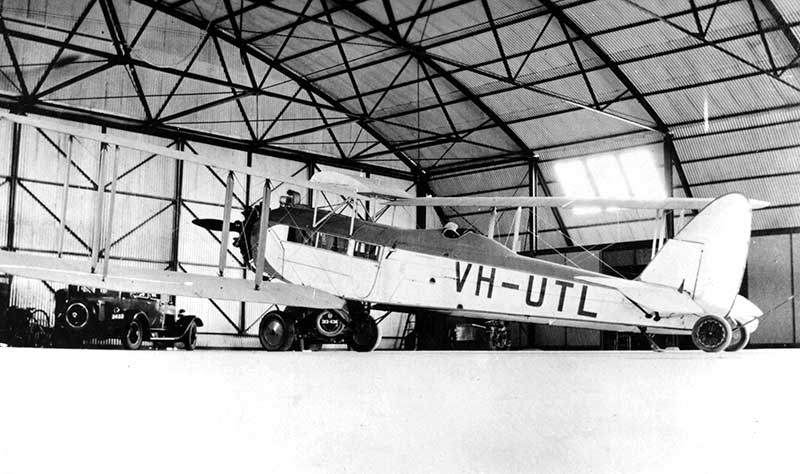
Photo courtesy Civil Aviation Historical Society
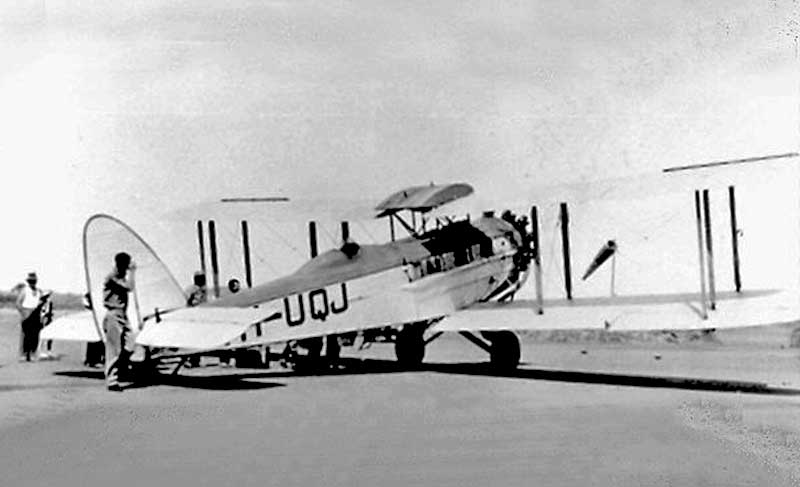
The second Dragon VH-URO was assembled at Maylands in April 1934 and prepared for the East-West route with 6 passenger seats but no toilet. It carried emergency provisions of biscuits but initially no drinking water because of the weight. A landing light was installed on the right side of the nose. It departed Maylands on 24 April 1934 on its first service to Adelaide
The hapless passengers were forced to wait for a WAA DH.50 to arrive from Perth to continue their flight to Carnarvon.
Dragon VH-URE was transported to Maylands where it was rebuilt over the next 4 months. But by then WAA had learnt that it had lost the NorthWest route and both Dragons was used on the Adelaide run.
| c/n |
Entered service |
Fate |
|
| DH.61 VH-UTL |
326 |
5.31 |
Sold 6.35 to Guinea Airways. Shipped to Lae |
| DH.61 VH-UQJ |
331 | 2.32 | Sold 6.35 to Guinea Airways. Shipped to Lae |
| DH.84 VH-URE |
6029 |
8.33 |
Sold 1.7.36 to Adelaide Airways, to ANA |
| DH.84 VH-URO |
6068 |
4.34 |
Sold 12.34 to W.R.Carpenter: ferried to New Guinea |
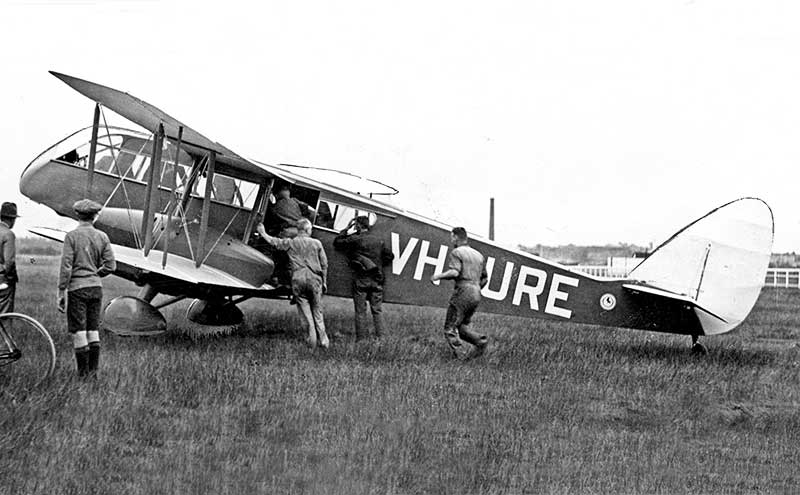
DH factory to allow extra passengers while joyriding, still a regular revenue-earner in 1933
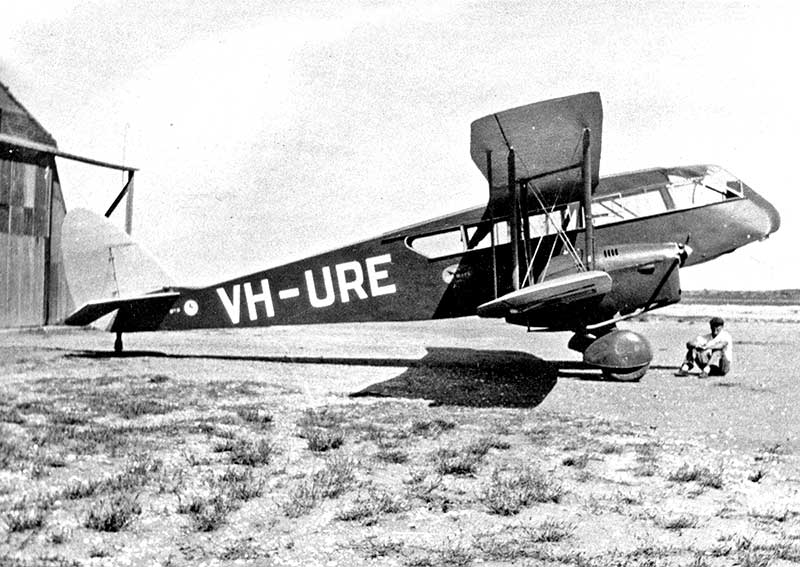
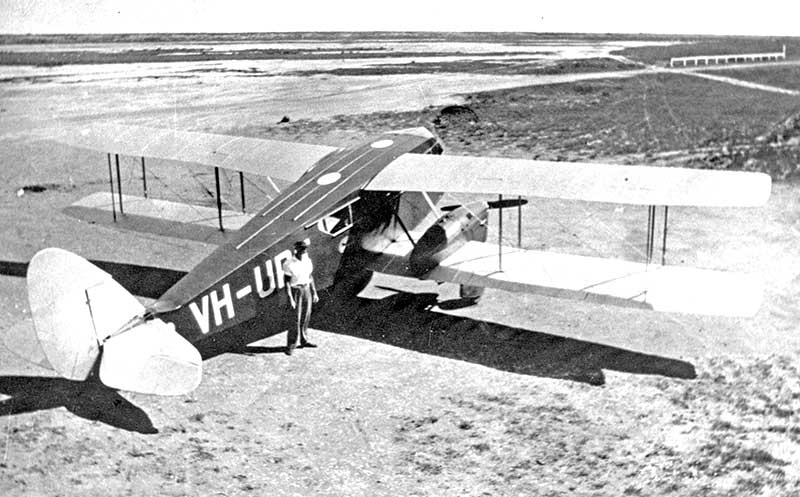
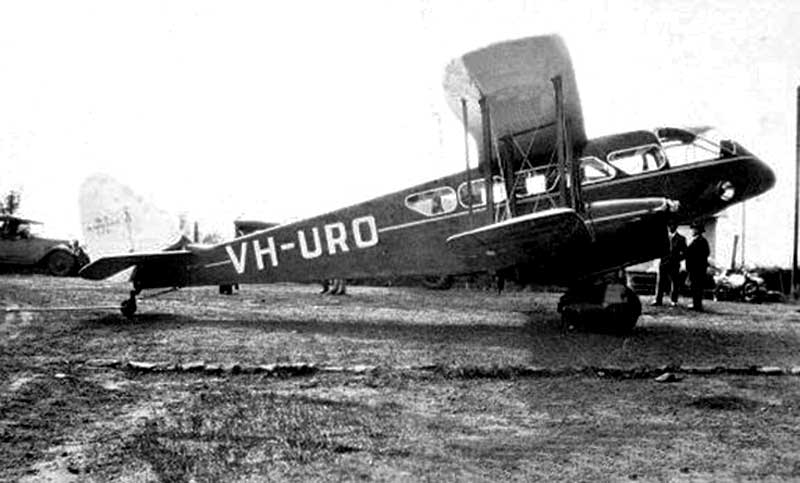
The final West Australian Airways North-West service departed Wyndham on 26 September 1934 for Perth, the DH.61 flown by Arthur Affleck with a full load of 9 passengers, mail and freight, plus 4 spare propellers lashed to the lower wings. An era had ended.
First order of business after the loss of the North-West service was to sell assets and reduce staff. Disposal of redundant aircraft was top priority but sale prospects were limited. Norman Brearley flew to Melbourne to talk with Guinea Airways pilot/manager Ian Grabowsky who was in hospital after being repatriated from New Guinea for serious surgery. Brearley wanted Guinea Airways to purchase the two Giant Moths at his price and needed Grabowsky to use his influence on reluctant Board members - Brearley also suggesting that otherwise he would send the aircraft to New Guinea and start a new airline in direct competition with the Guinea Airways. He got his sale and the two DH.61s were shipped from Perth to Lae, New Guinea in June 1935 as cargo on the steamer Karoola.
Only one Dragon was needed for the Adelaide run and VH-URO was sold W.R. Carpenter & Co to replace a crashed Fox Moth with their Mandated Airlines operation in the New Guinea goldfields.
WAA Chief Pilot Captain James Woods had accepted Horrie Miller's offer to join MMA in the same role, followed by other WAA pilots and mechanics taking jobs with MMA.
The DH.84 Dragon VH-URE now became the primary aircraft for the Perth-Adelaide weekly service in each direction, with remaining unsold aircraft used as back-up to cover for delays and unserviceabilities. The Dragon was efficient and reliable, but slow. Brearley was in talks with de Havillands regarding the better performing development DH.89 Rapide, when in June 1935 WAA was able to purchase a second-hand DH.89 already in Australia. This aircraft ZK-ACO had been a New Zealand competitor in the previous November's Centenary Air Race from London to Melbourne, and was now available for sale in Melbourne. Registered VH-UUO, it was ferried to Perth in June 1935 The Rapide's inaugural service departed Perth on 9 July 1935 flown by Len Diprose and immediately posted record fast times along the route:
Departed Perth at 10.45am, 75 minutes behind schedule because of the late arrival of the mail boat from Britain.
Perth-Kalgoorlie 1 hr 55 mins
Kalgoorlie-Forrest 2 hr 25 mins. Overnight at WAA Hostel at Forrest Aerodrome
Forrest-Ceduna 2 hr 10 mins. Departed at 7.05am.
Ceduna-Adelaide 2 hrs 00 mins
Landed at Parafield Aerodrome, Adelaide at 12.00 Noon
The near-new Rapide took over the East-West route, with the Dragon VH-URE as back-up. The regular pilots were Len Diprose and
Harry Baker. Remaining WAA aircraft, including the two Viastras and a DH.66, were stored in the Maylands hangar. The other DH.66 VH-UJO was held unserviceable in the Forrest hangar.
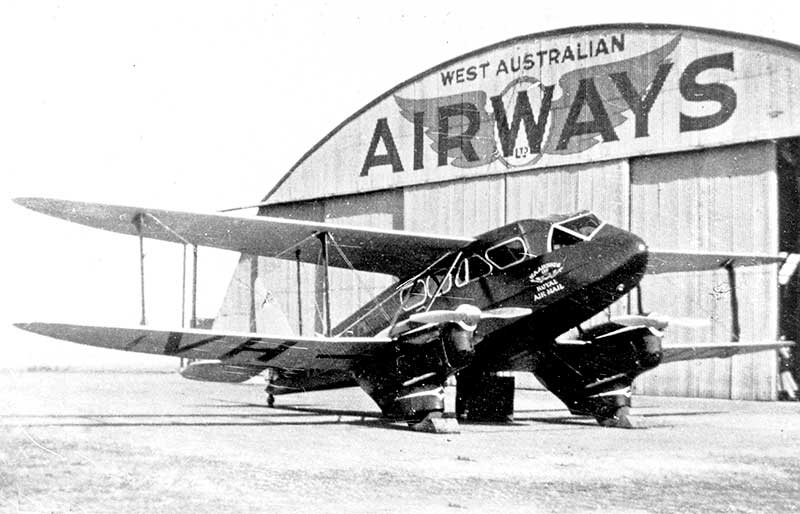
David Freeman collection, courtesy SA Aviation Museum
Holymans Airways Pty Ltd which operated from Tasmania to Melbourne and Sydney as a subsidiary of the shipping line William Holyman
& Sons Pty Ltd was negotiating a merger with the Directors of Adelaide Airways Ltd which was founded by The Adelaide Steamship Company and Orient Steam Navigation Co Ltd. To extend the route coverage of the planned new airline, it was decided that an offer be made to WAA to take over their operation and all assets, to gain the Adelaide-Perth route. Norman Brearley and the WAA Board of Directors decided the best outcome for their shareholders was to accept the financial offer, which was made through Adelaide Airways.
Effective 1 July 1936 Adelaide Airways took over West Australian Airways.
There was little immediate change on the Adelaide-Perth service, with Rapide VH-UUO continuing on the route but operated by Adelaide Airways. Effective 2 November 1936 Adelaide Airways and Holymans Airways were taken over by the newly-formed company
Australian National Airways Pty Ltd. Soon ANA Douglas DC-2s were flying Melbourne-Adelaide-Perth, an unimaginable improvement under the existing structure of the independent WAA.
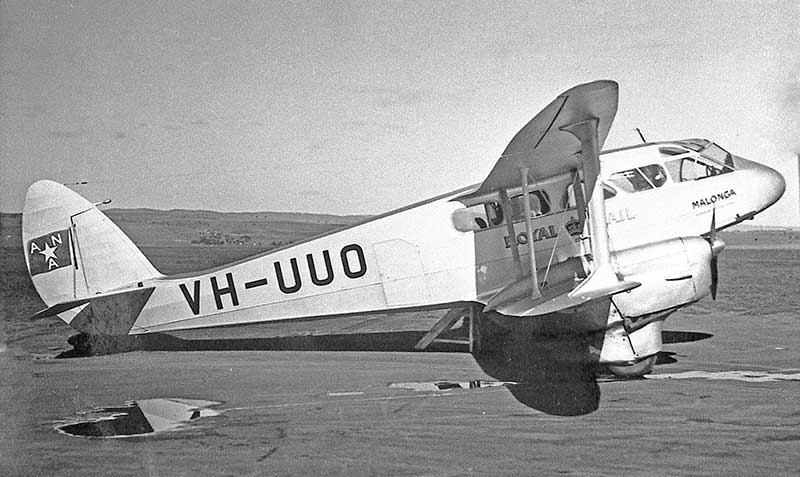
Meanwhile Norman Brearley went on to a long business career in Perth. During WWII he enlisted in RAAF and was appointed Commanding Officer at RAAF stations Geraldton and later Tocumwal. He was an advisor on pilot training to the wartime Air Board.
Following the war he retired in Perth but was a Director on the boards of several business companies for many more years. He was knighted in 1971 for services to aviation. Sir Norman Brearley C.B.E., D.S.O., M.C., A.F.C., F.R.Ae.S, died on 9 June 1989 in Perth aged 99.
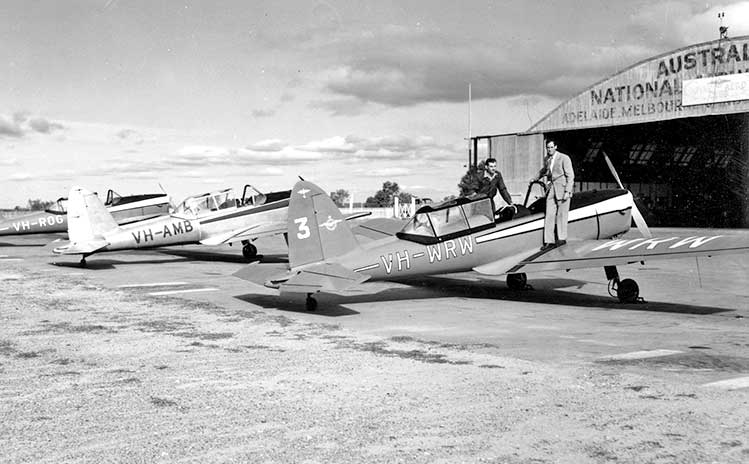
The ANA signage was still visible in this 1954 picture when the hangar was used by Royal Aero Club of WA
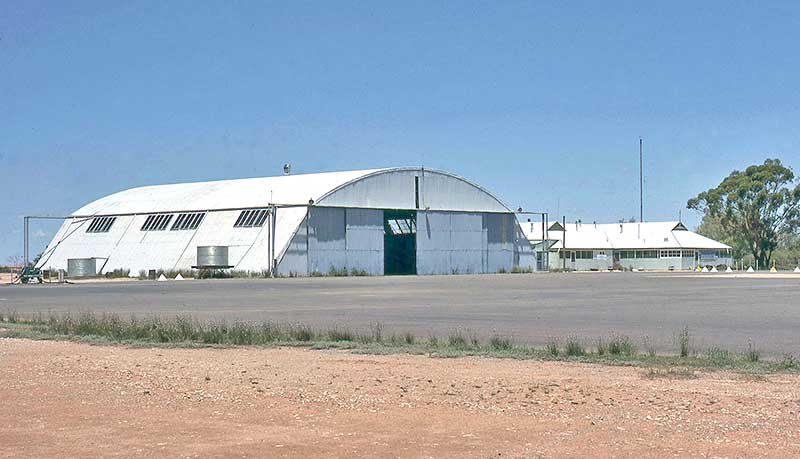
West Australian Airways heritage at Forrest Airport on the Nullarbor Plain in 1978. The 1929 hangar is still used today by
transiting aircraft, but the hostel building was demolished during the 1990s. Photo by Geoff Goodall
transiting aircraft, but the hostel building was demolished during the 1990s. Photo by Geoff Goodall
- Australian Aviator, Sir Norman Brearley CBE, DSO, MC, AFC, FrAeS, Rigby 1971
- Australia's Two Airline Policy, Stanley Brogden, Melbourne University Press, 1968
- Jimmy Woods - Flying Pioneer, Julie Lewis, Fremantle Arts Centre Press, 198
- Flypast - A Record of Aviation in Australia, Neville Parnell and Trevor Boughton, Civil Aviation Authority, 1988
- West Australian Airways, Geoff Goodall, Aviation Historical Society of Australia Journal, July 1971: see Publish Articles this website
- First Years of the North-West Air Mail Service, Leigh Edmonds, AHSA Journal, March 1992
- Forrest Airport www.forrestairport.com.au
- The Other Norman Brearley, Ted Fletcher talk: https://www.youtube.com/watch?v=k9_gFsZc5cU